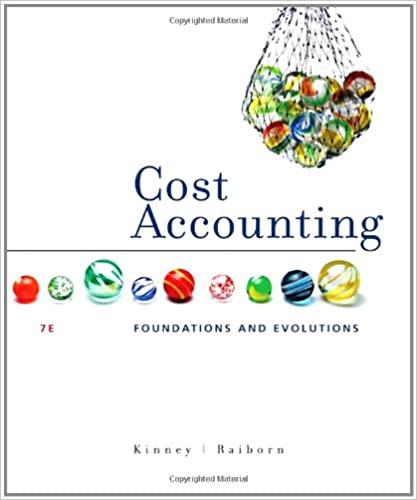Question
A manufacturing company has a plant with the two departaments: Department A and Department B. The plants overhead includes the plant managers salary, warehouse staff
A manufacturing company has a plant with the two departaments: Department A and Department B. The plants overhead includes the plant managers salary, warehouse staff and equipment and is budgeted in the amount of EUR 200,000. Last year, the actual plants overhead was EUR 190,000. Departments A and Departments B overhead consists mainly of depreciation and other machine-related expenses. The following data represent the plants performance for the last year:
Department A Department B
Budgeted department overhead
(excluding plantwide overhead) EUR 100,000 EUR 500,000
Actual department overhead EUR 120,000 EUR 550,000
Expected activity:
Direct labor hours 50,000 10,000
Machine hours 20,000 20,000
Actual activity:
Direct labor hours 51,000 9,000
Machine hours 22,500 22,000
In order to prepare the price proposal for several jobs for the upcoming period, the following data referring to the job No.100 is available:
Direct materials EUR 20,000
Direct labor cost:
Department A (2,000 hours) EUR 30,000
Department B (400 hours) EUR 6,000
Projected machine hours:
Department A 600
Department B 1,200
Units produced 10,000
Please round overhead rates and unit costs to the two decimal places and round other cost calculations to the nearest currency unit and perform the following:
- Assume that the Company uses a single overhead rate allocation method to assign plant and department overhead costs to jobs. Use expected direct labor hours to compute the overhead rate. Find the overhead rate and determine the projected amount of total manufacturing costs per unit for the units in the job No.100.
- Recalculate the projected manufacturing costs for the job No.100 using the three separate rates: one rate for plant overhead and the two separate department overhead rates, all based on machine hours.
- The Company sales policy states that job price proposals are calculated by adding 30 percent to total manufacturing costs. What would be the price proposal for the job No.100 using (1) the overhead rate from Question 1 and (2) the overhead rate from Question 2? Please explain why the price proposals differ. Which of the overhead allocation methods would you recommend and why?
- If a subcontractor offered to produce the parts for the job No.100, what should be the price per unit as offered by the subcontractor for the Company to be indifferent (i.e., to produce in-house or outsource with the same economic effect)? The assumption is that the Company sales force has already committed to the price proposal based on the calculations in Question 2. Please explain.
Step by Step Solution
There are 3 Steps involved in it
Step: 1

Get Instant Access to Expert-Tailored Solutions
See step-by-step solutions with expert insights and AI powered tools for academic success
Step: 2

Step: 3

Ace Your Homework with AI
Get the answers you need in no time with our AI-driven, step-by-step assistance
Get Started


